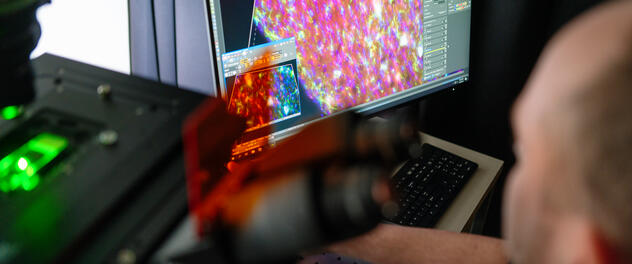-

Unraveling the cellular origins of cognitive decline
Dr. Schafer's Brain and Systemic Aging Lab studies how age-related changes in the brain and body increase risk of cognitive impairment and dementia.
-

Unraveling the cellular origins of cognitive decline
Dr. Schafer's Brain and Systemic Aging Lab studies how age-related changes in the brain and body increase risk of cognitive impairment and dementia.
-

Unraveling the cellular origins of cognitive decline
Dr. Schafer's Brain and Systemic Aging Lab studies how age-related changes in the brain and body increase risk of cognitive impairment and dementia.
-

Unraveling the cellular origins of cognitive decline
Dr. Schafer's Brain and Systemic Aging Lab studies how age-related changes in the brain and body increase risk of cognitive impairment and dementia.
-

Unraveling the cellular origins of cognitive decline
Dr. Schafer's Brain and Systemic Aging Lab studies how age-related changes in the brain and body increase risk of cognitive impairment and dementia.
Overview
Aging is the most powerful risk factor for cognitive impairment and dementia, yet the underlying biology is not fully understood. Mayo Clinic's Brain and Systemic Aging Lab, led by Marissa J. Schafer, Ph.D., studies how aging alters interconnected brain and body systems at the cellular and molecular levels. The central mission of this team is to discover how aging processes such as cellular senescence and chronic inflammation contribute to brain aging. We also study how medical and lifestyle-based interventions can target these processes and prevent or reverse systemic and cognitive decline.
Our research bridges disciplines and organ systems in preclinical models and human studies to better understand how the body communicates with the brain during aging and disease. We use field-leading techniques to investigate how age-related cellular changes disrupt brain and systemic function, with approaches spanning:
- Cellular and molecular biology.
- Cognitive function and behavior.
- Proteomics.
- Single-cell and spatial omics.
We are committed to translating our insights into actionable strategies — including targeted therapeutics, senescence-modifying compounds, and modifiable interventions such as diet and exercise — to help maintain brain and systemic health across the lifespan.
Advancing brain health and aging-related care
Our research drives advances in patient care by identifying fundamental aging processes that lead to cognitive decline. This can help us understand how brain dysfunction occurs and help us develop more-effective solutions and promote health into late life. The impacts of our research include:
- Maintaining cognitive health in aging. By identifying the root causes of age-related brain dysfunction, we aim to develop early interventions that preserve cognition and improve quality of life in later years.
- Understanding cellular changes in vulnerable brain regions to limit decline. We are uncovering how cells function differently as they age and disrupt normal communication in specific brain regions. We are finding ways to target these local changes to restore brain function.
- Determining the impacts of systemic aging on brain health. We investigate how aging in peripheral tissues, such as the immune system and vasculature, can influence brain aging through circulating molecular signals.
- Using new technologies to transform aging research. Spatial single-cell tools and interactome mapping are revolutionizing how we detect early signs of dysfunction and design precision therapies to target aging processes.
Focus areas
Our research centers on four key themes surrounding healthy brain and systemic aging:
- Aged brain cell fate and interactomes in vulnerable regions. We investigate how aging reshapes brain microenvironments, with a focus on the identities and interactions of senescent and inflammatory cells. These cells accumulate in specific regions and contribute to brain circuit dysfunction and cognitive decline.
- Systemic signaling and interorgan communication. We study how aging tissues influence the brain through bloodborne signals, particularly proteins secreted by senescent or inflammatory cells, that shape brain aging trajectories. Our work investigates circulating factors that advance aging — also called progeronic factors — as well as factors that slow or even reverse it, known as rejuvenative factors. We aim to define the origins of these factors, understand how they influence the brain, and reveal how they can be leveraged as biomarkers and therapeutic targets.
- Targeting dysfunctional cell states in aging. We develop and test therapeutic strategies, including pharmacological agents and lifestyle choices, that eliminate or reprogram harmful aged cells, such as senescent or chronically activated immune cells. The goal is to preserve brain function and promote resilience in aging.
- Uncovering sex-specific differences in aging biology. We explore how biological sex shapes cellular aging in the brain and body. Our aim is to understand why people of different sexes experience aging and cognitive decline differently and how these differences can inform tailored therapeutic strategies.
Recent discoveries
Senescent brain cells drive inflammation and cognitive decline
Our research has shown that two key cell types — myeloid cells and oligodendrocyte precursor cells (OPCs) — acquire senescentlike features in the aging brain. Senescent myeloid cells adopt a disease-associated activation state and secrete inflammatory senescence-associated secretory phenotype factors. These factors recruit peripheral immune cells, fueling neuroinflammation and cognitive dysfunction. In parallel, OPCs show hallmark signs of senescence, with distinct identities in aged gray matter and white matter brain regions. Importantly, targeting p16-positive senescent cells for removal rejuvenates aspects of the brain's immune landscape and improves cognitive outcomes, establishing these cells as actionable targets for preserving brain health in aging.
Spatial mapping uncovers age-altered cells and their interactomes
We developed spatial mapping tools to uncover age-altered cell states in vulnerable brain regions. We used spatially resolved transcriptomic and proteomic platforms to map how aging reshapes cell identities and interactions in specific brain niches. This mapping includes the precise localization of senescent cells — one prominent example of age-altered cell fate — as well as other molecularly distinct cell states that emerge with age. By capturing the spatial organization of these cells and their interactions with neighboring cell types, we are uncovering how localized microenvironmental changes contribute to cognitive vulnerability. This allows us to identify potential targets for intervention.
Circulating proteins act as biomarkers for aging
We have shown that circulating proteins, including soluble IL-23R, can serve as biomarkers and potential mediators of systemic aging and senescence. Through integrative proteomic analyses in mice and humans, we identified soluble IL-23R as a senescence-associated circulating factor that increases with age. We are investigating IL-23R and other circulating factors as biomarkers of aging and as functional mediators of interorgan communication that contribute to systemic dysfunction. These discoveries highlight the potential for targeting senescence-associated secreted proteins to modify age-related decline across multiple tissues.